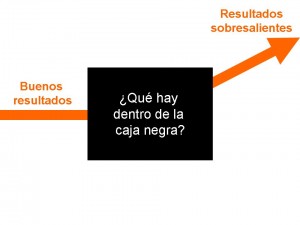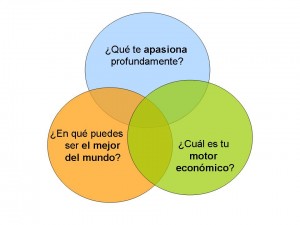The best book I’ve read until now about enterprise strategy is “Good to Great” by Jim Collins. In it there is a summarized study made by the author and his team about 27 enterprises of the United States: 11 of them, the ones called “good to great”, had 15 years of results at the same level or below the market level and, after a transition point, they accumulated during the next 15 years results at least 3 times higher than the market ones.

In this study, these enterprises are compared one by one with another 11 enterprises, from the same sector, with the same opportunities and similar resources at the time of the transition but that didn’t experiment the changes other enterprises did, and with another 6 enterprises that experimented a little twist from “good to great” but that failed in keeping their ascendant trajectory.
Jim Collins and his team studied what those enterprises that got extraordinary results in the market in a continuous way had in common and that it was also something that the other enterprises from the comparison didn’t have. They found 7 patterns that every enterprise that became outstanding applied.
These 7 patterns seem extraordinary for me because of their simplicity and easy implementation. Despite that, don’t forget that all of them must be applied, something that not many enterprises seem to do.
1. Level 5 leaders
One of the great surprises of the study was to discover that the kind of leaders running those enterprises at the moment of the transition had two common characteristics: personal humbleness and professional will to make from the enterprise an outstanding one.
How many of you would stress the humbleness as a characteristic of your enterprise’s managers?
2. First choose who and then what
Another expected result of the study was that the leaders started their mandate establishing both new vision and strategy. However, the level 5 leaders first chose the right people to get on the “bus”, and got of the “bus” those who are not appropriate, sit everyone in their right seat and then, all together, decide where to go.
We are no longer saying that “people are the most valuable assets” but “the right people are the most valuable assets”
3. Face the facts (and never lose faith)
You must keep the faith in getting what you want despite difficulties and at the same time, you must have discipline to face your reality’s most brutal facts, whatever your reality is.
4. The Hedgehog concept
All enterprises found their hedgehog concept, the intersection of this 3 circles:
- En
- What’s the one thing you can be the best in the world? And equally important, what you can’t be the best in the world at. (Maybe it is something you are not even working on yet)
- What is your economic motor? All the enterprises found the denominator that had the higher impact in their economy: “profit per…” (employee, establishment, etc.)
- What are you really passionate about? Focus your effort in those activities that light on your passion!
Beware, the hedgehog concept is not a goal, strategy or intention of being the best, but it’s about understanding what you are the best at.

5. Discipline culture
Every company has culture, some have discipline, but very few have a discipline culture.
When you have disciplined people, you don’t need hierarchies. When you have disciplined thinking, you don’t need bureaucracy. When you have disciplined action, you don’t need excessive controls. When you combine disciplined culture with an ethical idea of beginning, you get the magical formula for a great performance.
6. Technological accelerators
Great enterprises think different about the role technology plays. They never use it as a mean for the transformation ignition and, yet, they are pioneers applying technology carefully chosen.
7. The driving wheel and the definitive push.
According to the study results, those who start revolutions, programs with drastic changes and painful reorganizations, probably won’t make the change to a great enterprise. This study showed that the enterprises that made it were never transformed through a great action, a great program, a great innovation, a stroke of good luck or a miracle. What happened was that all of them pushed a big and heavy wheel restlessly and in one direction, turn after turn, building until that definitive instant when the wheel started turning almost by itself.
Summing up, disciplined people, disciplined thinking and a disciplined constant action focused into only one direction summarizes the 7 patterns or concepts to imitate by any enterprise that wants to became an outstanding enterprise. If you decide to try…good luck!
Source: “Good to Great”, Jim Collins